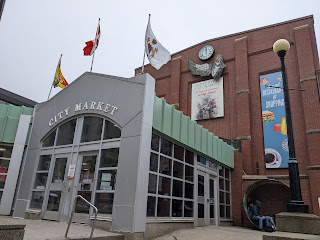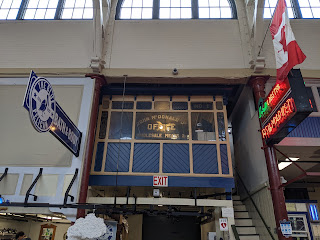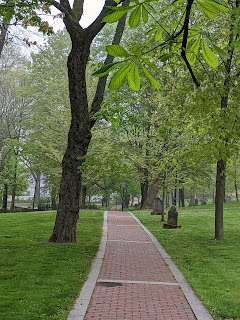
Our B&B in the heart of uptown Saint John was the Mahogany Manor and was owned by Carl and Jim Trickey-Crooks, certainly names we wouldn't soon forget! As I mentioned in earlier posts, my father grew up in Saint John, and even though Steven and I had made the long trek from Denver a few times so my paternal relatives could meet our children, it had been a long time since we'd been back. I'd forgotten how very small the city is in the sense of Carl knowing my cousin's wife from nursing school and later someone in the city market also knowing my cousins! If you're ever looking for a place to stay in Saint John, it'd be hard to beat Mahogany Manor's location and scrumptious breakfasts.
The B&B was a two-story, Queen Anne Revival home that had been constructed in 1905 for the manager of a wholesale grocery firm. Located on Germain St, it was one of the few wooden homes on the street that had been named for the English statesman and soldier, Lord George Germain, who died in 1785 just as the city's streets were being named.
After the Saint John Great Fire of 1877, many new homes were constructed of brick to replace those that had been lost in the fire. The most prosperous boasted Honduran mahogany, Italian marble mantlepieces, and intricately carved newel posts and doors. Even though it was just a few blocks from the city center, Germain Street with some of the best post-1877 residential architecture, was considered one of Saint John's most elegant, older residential streets.
A couple of houses down was the 1880s Rankin House which was unusual from pre-fire practice because it was a double or multiple dwelling.
A plaque at the McMillan House next door indicated that Saint John's first frame building was erected on this site in 1784 and it served as Trinity Church as well as a courtroom and common council chamber. The royal arms were brought here from Boston in 1785. The stone Second Empire-style building that took its place in 1884 was built for J. McMillan, a stationer, printer, and bookseller.
Across the street at 227 Germain was the imposing Carleton House built in 1888 for Sir Samuel Leonard Tilley, one of the 36 Fathers of Confederation who represented British North American colonies at one or more of three conferences that led to Confederation and the creation of the Dominion of Canada in 1867.
At 197 Germain were the McArthur Apartments erected in 1920 for George McArthur, a proponent of the nine-hour work day. The nine-story brick building was the city's first high-rise apartment structure.
Further down Germain was Trinity Church which was built in 1880 to replace the former wooden Old Trinity that had burned down in the Great Fire. If we'd gone inside the church, we'd have seen the House of Hanover Coat of Arms that had been "rescued" from the old Boston Council Chambers after the American Revolution. I wonder if the word 'rescue' would be the one used by Americans!
I was frankly surprised that there was no description of this handsome building on the corner of Germain in the walking tour booklet as we thought it more striking than others on the street.
King St. was formerly known as Great Georges St. in honor of King George II. It's hard to imagine now but it was considered a suburb until the early 1800s!
The Commercial Block which originally had four similar buildings, each four stories high, was constructed in 1878. After the corner one was destroyed in a fire in 1906, additional stories were added to the other three buildings.
There's a funny story behind the Vassie's Corner also on King St. It turns out that Benedict Arnold lived in a large frame house on this corner in 1787 but he was so heartily disliked by the local citizenry he was burned in effigy. The current structure was built for a wholesale dry goods merchant in 1878. Painted crosses on and under windows on the upper levels were placed there as an indication of where occupants gathered in the event of a fire.
At the bottom of King St., a clock commemorated the 225th anniversary of the incorporation of Saint John on May 18th, 1785, as Canada's first incorporated city. It also recognized May 18th in Saint John as Loyalist Day marking the arrival of the first of over 10,000 Loyalists or 'refugees' from the newly independent American states in 1783.
The centennial of Canada's Confederation was marked in 1967 by the moving of Barbour's General Store from a rural crossroads 80 miles north of Saint John to the location in the city where the G.E. Barbour Company first went into business.
Across King St. was Market Square, a redeveloped shopping plaza on the site which was the center of the city's dry goods trade immediately following the Great Fire. Numerous warehouses had held cargo from around the world. The sculpture was called People Apart Moving Together.
It was a tad odd seeing this mini lighthouse outside Market Square but we sure wouldn't have been able to see it if it were far away as the notorious Saint John fog rolled in and we could see nothing!
It had been one thing reading dispassionate accounts of The Great Fire and how it had affected some of the city's buildings. But seeing this map and hearing about the devastation the fire wrought in 1877 wasn't something we could tuck away in the back of our minds.
A few statistics about the fire's devastation: 200 acres burned, 40% of the city gone, 1,612 structures gone including those made of stone and 1,000 homes, and 600 businesses. I found it amazing that just 12 people lost their lives from burns while 6 more either drowned or were struck by falling debris.
A mountain of coal that had been used to pipe gas throughout the city for illumination burned for 10 days after the fire. Twenty-five percent of the city's population was left homeless and thousands of people were suddenly unemployed. They had three options: live in shanty towns that sprang up around the city; relocate within the city; or leave town and start somewhere else. Many chose this last option.
The fire caused $27 million in losses or $500 million in today's currency. Thankfully, donations poured in to the city including from overseas.
The rebuilding story: 1 year later, shanties were gone; 2 years later, 90% of rebuilding was complete; 4 years later, large public buildings and 1,100 new buildings were also complete; and 40 years later, the city finally recouped its population loss.
A plaque indicated the row of similar townhouses on Chipman Hill reflected the taste of the High Victorian era with wall and ceiling trompe l'oeil paintings combining classical and Renaissance influences.
We were very lucky that the building owner had the outer door open so people could peek in and look at the paintings with their illusion of sculpture, wall paneling, materials, and textures. They were likely executed in the 1870s as an expression of the wealth of a successful entrepreneur. These paintings were a rare surviving example of early artistic painted decoration in a Canadian home.
The Saint John Arts Centre opened in 1904 as one of the 2,509 public libraries donated by Andrew Carnegie to communities in North America. Of the 125 Carnegie libraries gifted to Canada, this one in Saint John was the only one in all of eastern Canada!
The stained-glass ceiling in the almost three-story-high rotunda looked like it would have been at home in an opera house!
It's hard to see but this Georgian-style Loyalist House was built directly into bedrock between 1810 and 1817. I was surprised that the American Association for State and Local History recognized this structure for its excellence in restoration.
I can't for the life of me begin to understand why there was a mural promoting Santorini, Greece here in Saint John!
The three-story, Georgian-style, 1819 Nutting House was important because it was the oldest surviving brick building in Saint John.
Saint John's City Market has been a city fixture since 1876 and is believed to be Canada's oldest farmers' market building. I fondly remember as a young child visiting the market with my father when our family visited his hometown to see his siblings.
On the market's outside wall was a sculpture called Figurehead that was a stylized interpretation of those who guarded wooden sailing ships. Made of individually sculptured clay tiles affixed to a fiberglass background, each tile was fired and glazed to form the entire figure and withstand the test of time.
The market's interior roof supports were designed to look like a ship's hull in recognition of the city's marine history. Though the market's exterior may have been updated since I was a child, the interior hadn't changed one iota in all my visits from when I was a child or even those with Steven.
This was the first time in easily 30 years I'd seen fiddleheads for sale anywhere!
I wouldn't have been surprised to learn if wholesale merchant John McDonald whose offices were upstairs in the market was any relation as my grandfather, also a McDonald was in the grocery business. One of my four brothers and two of my cousins were also named John.
Seeing the bags of dulse also brought me back to my childhood as my father loved chomping on the sea vegetable that is grown at low tide and takes root on rocks! It is harvested by hand and sundried on a special drying ground. Most people enjoy it as is but it can be toasted in a pan for a few seconds, microwaved, or added to soups and salads as a seasoning. The local delicacy is harvested from June-November. Chris and John: I brought a bag back for you both to enjoy - I just hope it's still fresh enough as it's traveled literally thousands of miles and been in all sorts of weather since Saint John!
The market's other entrance:
Across from the market was King's Square, one of four squares listed in the original town plan. The two-story bandstand was donated by the City Cornet Band as a memorial to King Edward VII.
The statue honored Tilley, one of the Fathers of Confederation I wrote about above.
Across from King's Square was the Old or Loyalist Burial Ground which was set aside as a public ground in the original town plan. The oldest surviving stone dates to 1784. There have been no further burials here since 1848.
We tried but failed to read any of the names or dates on the ancient gravestones.
Another building of note was the County Court which was built in 1825 and used right up until 2012.
When the Carson Flood House was built in 1878, it was featured in the American Architect & Building News. The first owners, the Taylors and Dearborns, had the first letter of their surnames carved above the doorways for posterity!
The five-sided bay window dormers on the roofline of the Osgood House are known as Scottish dormers. They were very common on many of the 19th-century homes in Saint John.
Steven and I both gulped on finding out that this home on Pitt St. made it into the Victorian Stroll as it sure looked like its best days were far behind! It was tough seeing what was described as the "richly detailed, gaily painted" home and appreciate the "high-quality craftsmanship" which was available from shipbuilders.
The fog had blotted out our views down to the Bay of Fundy, unfortunately.
One of the largest homes we saw thus far in Saint John was the Wright Home that was constructed in 1902 in the Queen Anne Revival for the manager of North American Life Insurance Company.
Charles H. Peters had this impressive home built over a three-year period beginning in 1897 on Leinster St. When it was completed, it was reputed to be the best-finished home in the city. In 1965 it was converted to a funeral home. In 2008 the building became the new home for the Congregation Shaarei Zekek and the Saint John Jewish Historical Museum.
Definitely not listed in any tour guide on Saint John was this home at 231 Princess St. that belonged to one of my father's sisters and her family! I recall so many fun times with my Aunt Josie and Uncle Jack when I was growing up and also bringing our four children there to visit when we camped nearby.
Janina: Many thanks for the warm knitted hat you gave me as it came in so, so handy that chilly day!
The Troop House on nearby Wentworth St. was named for Jacob Valentine Troop who parlayed his fortunes from a single 60-ton wooden schooner to a shipping fleet whose flag was recognized around the world. After the first home on this site was destroyed in the Great Fire of 1877, this house was completed the following year.
This street was named for Sir John Wentworth, the second Governor of Nova Scotia after having served as the last Royal Governor of New Hampshire before the American Revolution. This sounded like landing on the right side of the bed!
Looking down Wentworth St. from adjacent Orange St., we could see by the commanding view of the harbor why shipowners built homes along Orange Street. This vantage point provided them with an opportunity to keep a watchful eye on their ships.
Like others on Orange Street, Gilbert Bent had an interest in ocean-going commerce. As the owner of a food wholesale firm, he also wished to keep an eye on shipping movements and had this Second Empire sandstone home built in 1879. The initial of the family name was carved in stone above the doorway.
I liked the intricate stone carvings above the window on the home next door ...
and the etching above the stone doors on another home,
and the curved glass windows in the turret of the former Trinity Church rectory.
Painted clapboard houses were a common sight on Duke St.
The elegant Caverhill Hall was built in early 1884 for Simeon Jones, a brewer, and banker. When the Duke and Duchess of Cornwall and York, later King George V and Queen Mary, came to Saint John during a Vice-Regal visit in 1901, they stayed at Cavehill Hall. Simeon’s son, Captain Rae Jones, was the first Saint John man killed in WW I.
I'm sure you figured that if there's a King's Square in Saint John then surely there has to be a Queen's Square right?! Well, you'd have been nearly right as this was Queen Square, one of the most fashionable districts in the city with homes surrounding the square built by wealthy citizens following the Great Fire of 1877. The square itself was laid out in 1783 in the shape of an ‘X’. The monument of the city's founder, Samuel de Champlain, was erected to mark the 300th anniversary of his naming the St. John River.
No visit to Saint John would be complete without trying to see the famous Bay of Fundy tides even in a fog! The body of water in front of us was actually the intersection of two incredible water sources: the St. John River and the Bay of Fundy.
The tides do battle with the river each day, creating an amazing effect, the actual reversal of the river's flow. These tides are the highest in the world and reach 56 feet at their highest, equivalent to the height of a five-story building! Though the views weren't the best, it was still pretty darn exciting thinking about the incredible power harnessed by the tides.
Even though Steven and I hadn't been able to see my cousin as I'd hoped, we still really enjoyed playing tourist in my father's hometown and remembering previous visits at various stages in my life.
Next post: Our next ferry ride took us from Saint John over to Digby and the lovely Annapolis Valley of Nova Scotia.
Posted on July 26th, 2022, from The Big Easy aka New Orleans, Louisiana, where we've come for three nights in between beach time in Florida and Alabama. This was a banner day for us as our first grandson was born earlier today in San Francisco!











































































I have no doubt your dad would have been thrilled to know you walked the streets of his hometown and viewed the Bay of Fundy through the fog, a common occurrence in Saint John, NB. xo xo
ReplyDeleteThanks, I hope so. I considered naming this post 'A Tribute to My Father's Hometown.'
ReplyDeleteWOW, there is certainly a lot of information on the houses in Saint John. I know there isn't that much here in Denver or most American cities. I remember the story of the tides at Bay of Fundy, that I must have seen in my childhood. Fascinating to a scientist. Janina
ReplyDelete